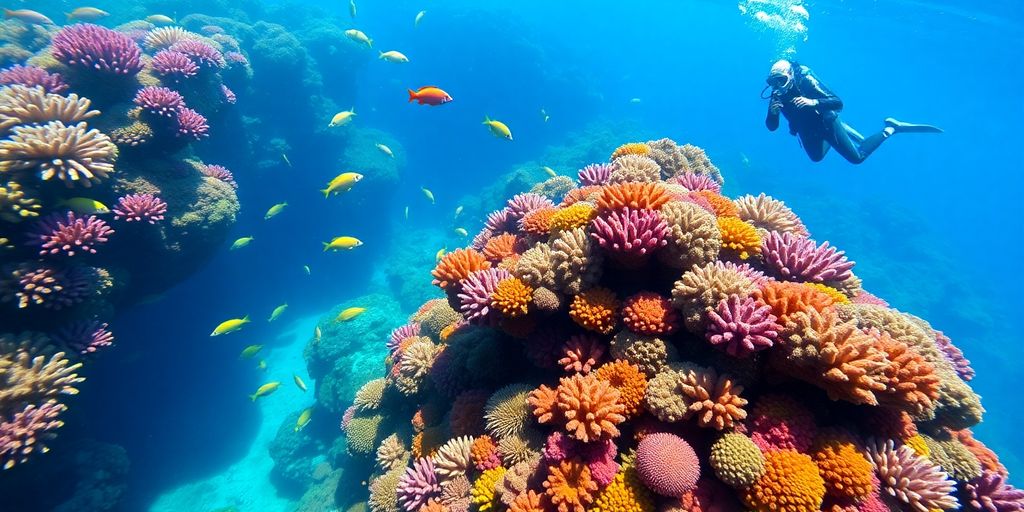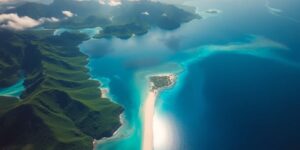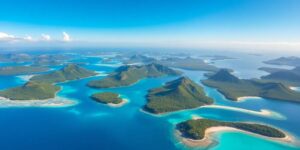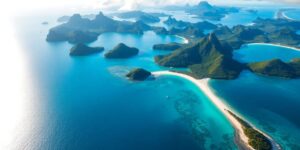Island-hopping in the South Pacific with the Air Tahiti Pass is like stepping into a whole new world. The marine life here is just incredible, and there’s something for everyone, whether you’re into snorkeling, diving, or just relaxing by the shore. You can swim with dolphins, spot colorful fish, or even dive with sharks if you’re feeling brave. Plus, there are tons of ways to help out with conservation efforts, so you can enjoy the ocean and give back at the same time. It’s an adventure you won’t forget.
Key Takeaways
- The South Pacific is a treasure trove of marine life, perfect for island-hopping adventures.
- Coral reefs, dolphins, sharks, turtles, and more await those exploring these waters.
- Ethical and conservation-focused tourism is key to preserving these marine wonders.
- Guided tours and citizen science projects offer unique ways to engage with the ocean.
- Marine reserves and protected areas play a vital role in sustaining marine biodiversity.
Exploring Coral Reefs in the South Pacific
Understanding Coral Ecosystems
Coral reefs are like bustling underwater cities. They’re full of life, color, and activity. These ecosystems are made up of tiny animals called coral polyps, which build the reefs over thousands of years. Coral reefs are essential for marine life; they provide food and shelter for a quarter of all ocean species. Without them, many fish and marine creatures would struggle to survive.
Best Snorkeling Spots for Coral Viewing
If you’re looking to experience the vibrant underwater world, the South Pacific is the place to be. Some of the best spots include:
- Fakarava, French Polynesia: Known for its clear waters and rich marine biodiversity.
- Vanuatu: A hidden gem, where coral reef conservation efforts are actively preserving the beauty and diversity of the reefs.
- The Cook Islands: A snorkeler’s paradise with colorful coral gardens.
Conservation Efforts for Coral Reefs
Preserving these underwater wonders is crucial. Many islands in the South Pacific are actively involved in coral reef conservation. They focus on community involvement, reducing pollution, and promoting sustainable tourism. These efforts help ensure that future generations can enjoy the breathtaking beauty of coral reefs.
Snorkeling in the South Pacific isn’t just about seeing fish and coral. It’s about connecting with a vibrant ecosystem and understanding why protecting it is so important. The Air Tahiti Pass offers a unique way to explore these hidden gems and witness the incredible marine life firsthand.
Swimming with Dolphins in Tahitian Waters
Dolphin Species in the South Pacific
When you’re in the South Pacific, especially around Tahiti, you’ll find a variety of dolphin species. Spinner dolphins are quite the acrobats, known for their playful spins out of the water. Then there’s the bottlenose dolphin, which is probably the most recognizable with its friendly demeanor and intelligence. Lastly, the rough-toothed dolphin, which is a bit more elusive but equally fascinating.
Guided Dolphin Tours
If you’re looking to encounter these amazing creatures, guided tours are the way to go. These tours not only ensure your safety but also enrich your experience with insights about dolphins. Here’s what a typical tour might include:
- A brief introduction about the species you might encounter.
- Safety measures and guidelines to follow.
- An experienced guide who can answer your questions and help spot dolphins.
Ethical Dolphin Encounters
It’s crucial to interact with dolphins responsibly. Always choose tours that prioritize the well-being of marine life. Ethical encounters mean:
- Maintaining a respectful distance.
- Avoiding feeding or touching the dolphins.
- Ensuring that the boat engines are off when near dolphins to minimize stress.
"Swimming with dolphins offers a unique connection to nature that is both thrilling and humbling. It’s a reminder of the beautiful, diverse life that thrives beneath the ocean’s surface."
Diving with Sharks: A Thrilling Experience
Types of Sharks in the South Pacific
Diving in the South Pacific means you might meet a variety of sharks. The most common ones include the blacktip reef shark, known for its striking black fin tips, and the curious gray reef shark. If you’re lucky, you might even spot a hammerhead shark. These majestic creatures are often seen in top drift diving locations like the Tuheiava Pass. Each species has its own behavior and charm, making every dive a unique adventure.
Safety Tips for Shark Diving
Diving with sharks can be exhilarating but safety is key. Here are some tips:
- Dive with a buddy – Never dive alone, especially in shark-populated waters.
- Stay calm – Sharks are curious but usually not aggressive unless provoked.
- Keep your distance – Admire these creatures from afar to avoid any unwanted encounters.
It’s also wise to check the local conditions and follow the guidance of experienced divers.
Shark Conservation Initiatives
Sharks play a crucial role in the marine ecosystem, and their conservation is vital. Many organizations are working to protect these magnificent creatures. Conservation efforts focus on:
- Reducing overfishing and bycatch in commercial fishing.
- Establishing marine protected areas where sharks can thrive.
- Educating the public about the importance of sharks in the ocean.
These initiatives are essential to maintaining the balance of marine life and ensuring that future generations can enjoy the thrill of swimming with whale sharks.
Shark diving isn’t just about the adrenaline rush. It’s about understanding and respecting these incredible animals that have roamed the oceans for millions of years. By diving responsibly, we contribute to their conservation and the health of our oceans.
Discovering Sea Turtles on Island Shores
Nesting Habits of Sea Turtles
Ever wondered about the nesting habits of sea turtles? These ancient mariners return to the same beaches where they were born to lay their eggs. It’s like a homecoming, but with a purpose. Female turtles come ashore at night, dig a hole in the sand, and lay dozens of eggs. This process can take several hours, and once done, they cover the nest with sand and head back to the ocean. It’s a cycle of life that has been happening for millions of years.
Best Times for Turtle Watching
Timing is everything when it comes to spotting these gentle giants. The best period to catch a glimpse of sea turtles is during the nesting season, which usually falls between May and October. Early mornings or late evenings are prime times for watching them scuttle across the sand. If you’re planning a trip, consider visiting exotic travel destinations that offer guided turtle watching tours.
Protecting Sea Turtle Habitats
Sea turtles face numerous threats from habitat loss to pollution. Protecting their nesting sites is crucial. You can help by supporting conservation efforts and participating in beach clean-ups. Here are a few ways to contribute:
- Avoid disturbing nesting sites.
- Participate in local conservation programs.
- Reduce plastic use to keep beaches clean.
Sea turtles are a vital part of the marine ecosystem. By taking small steps, we can ensure these majestic creatures continue to grace our shores for generations to come.
Observing Whales in Their Natural Habitat
Whale Migration Patterns
Every year, whales embark on an epic journey across the oceans. These majestic creatures migrate thousands of miles, following ancient routes that have been used for generations. Understanding these patterns can enrich your whale-watching experience, as you’ll know when and where to spot them. Generally, the best time to see these giants in the South Pacific is between July and November, when they travel to warmer waters to breed and give birth.
- Humpback Whales: Known for their acrobatics, they migrate from Antarctica to the warm waters around Tahiti.
- Blue Whales: The largest animals on Earth, often seen near the deep ocean waters.
- Sperm Whales: These deep divers are spotted year-round, but their numbers peak during migration months.
Top Whale Watching Locations
Tahiti offers some of the most incredible spots to witness these ocean giants. The islands provide a perfect backdrop for a memorable encounter.
- Moorea: Just a short trip from Tahiti, Moorea is renowned for its clear waters and frequent whale sightings.
- Rurutu: Known as the whale capital of the South Pacific, this island offers close encounters from July to November.
- Bora Bora: While famous for its lagoons, it’s also a great spot for whale watching when the migration is at its peak.
Impact of Tourism on Whales
Whale watching is a popular activity, but it’s crucial to consider its impact on these gentle giants. Responsible tourism practices help ensure that whales are not disturbed by human presence. Boats should maintain a respectful distance, and noise levels should be kept to a minimum.
"Whale watching can be a powerful way to connect with nature, but it’s important to prioritize the well-being of these creatures."
By choosing eco-friendly tours and supporting sustainable travel options like the Air Tahiti Pass, you can enjoy these experiences while ensuring the protection of marine life. Remember, our actions today shape the future of these incredible animals and their habitats.
Encountering Exotic Fish Species
Colorful Fish of the Coral Reefs
When you’re hopping from island to island with the Air Tahiti Pass, the underwater world is just as thrilling as the land above. The vibrant coral reefs in Tahiti are home to a dazzling array of colorful fish. From the playful clownfish to the elegant butterflyfish, every dive is like entering a living kaleidoscope. Imagine swimming alongside these vivid creatures in the warm, clear waters of Teahupo’o, Moorea, and Bora Bora. These spots are a must-visit for anyone eager to witness the spectacular marine life.
Rare Fish Species to Look For
While the common species are a joy to observe, keep your eyes peeled for the rarer ones too. The elusive Napoleon wrasse and the delicate Moorish idol are just a couple of the unique fish you might encounter. Each species adds a touch of mystery and excitement to your underwater explorations in French Polynesia. Remember, patience and a keen eye are your best friends when searching for these rare beauties.
Photography Tips for Capturing Fish
Capturing the beauty of these fish on camera can be tricky, but with a few tips, you can snap some impressive shots. First, make sure to use natural light whenever possible; early morning or late afternoon dives often yield the best results. Second, get as close as you can to your subject without disturbing them, as this will reduce the amount of water between your lens and the fish. Lastly, practice patience; sometimes the best shots come from waiting for the perfect moment. Whether you’re an amateur or a seasoned photographer, these tips can help you capture the essence of your underwater adventures.
Swimming among Tahiti’s fish is like stepping into a vibrant painting. Each encounter is unique, offering a glimpse into a world where nature’s palette knows no bounds.
Exploring Underwater Caves and Grottos

Famous Underwater Caves in Tahiti
Tahiti is home to some of the most breathtaking underwater caves and grottos you’ll ever encounter. These natural wonders offer a unique glimpse into the hidden beauty beneath the waves. From the mesmerizing blue hues to the intriguing rock formations, each cave tells its own story. One must-visit spot is the "Cave of the Bends," known for its stunning stalactites and crystal-clear waters. Another popular site is the "Grotto of the Pearls," where divers can marvel at the shimmering reflections of sunlight on the water.
Safety Precautions for Cave Diving
Diving into these underwater caves is thrilling, but it’s essential to prioritize safety. Here are some key precautions to keep in mind:
- Always dive with a buddy. Never explore these caves alone.
- Ensure your diving equipment is in top-notch condition before heading out.
- Familiarize yourself with the cave layout and potential exit points.
Marine Life Found in Caves
The caves and grottos of Tahiti are bustling with fascinating marine life. You might spot schools of vibrant fish darting through the shadows or encounter a curious octopus peeking from a crevice. Bioluminescent organisms often light up the darker areas, creating an otherworldly experience. These ecosystems are delicate, so it’s crucial to respect the habitat and avoid touching or disturbing the creatures you meet.
Exploring these underwater caves is like stepping into another world, where every corner reveals a new wonder. It’s a journey that reminds us of the vast and mysterious beauty of the ocean.
Kayaking Through Mangrove Forests

Biodiversity of Mangrove Ecosystems
Mangrove forests are like nature’s hidden treasure troves, teeming with life. These unique coastal ecosystems are home to a wide variety of plant and animal species. Mangroves serve as nurseries for fish and crustaceans, providing shelter and food for young marine life. You might spot colorful crabs scuttling along the roots or find birds nesting in the branches above. Mangroves also play a crucial role in protecting coastlines from erosion and storm surges.
Guided Kayak Tours
If you’re looking to explore these fascinating ecosystems up close, guided kayak tours are the way to go. These tours offer a safe and informative way to paddle through the winding waterways of the mangroves. Here’s what you can expect on a typical tour:
- Safety briefing: Learn the basics of kayaking and safety tips.
- Wildlife spotting: Guides will help you identify various species.
- Cultural insights: Discover the importance of mangroves to local communities.
Preservation of Mangrove Habitats
Preserving mangrove habitats is essential for maintaining biodiversity and protecting coastal areas. Efforts to conserve these ecosystems include planting mangrove saplings and reducing pollution. Local communities often participate in these initiatives, recognizing the importance of mangroves for their livelihoods and the environment. By joining a kayak tour with the Air Tahiti Pass, you can support these conservation efforts while experiencing the beauty of the mangroves firsthand.
Paddling through a mangrove forest is like stepping into another world, where the air is filled with the sounds of nature and the water reflects the vibrant green canopy above. It’s an experience that connects you to the natural world in a profound way.
Experiencing the Vibrant Marine Life of Lagoons

Unique Species Found in Lagoons
Exploring the lagoons of Tahiti is like stepping into a vibrant underwater world. These calm, shallow waters are teeming with an array of unique marine species. From the playful clownfish darting through sea anemones to the graceful manta rays gliding silently beneath the surface, there’s always something fascinating to see. Lagoons act as nurseries for many marine creatures, providing a safe haven for young fish and other aquatic life to grow and thrive. It’s common to spot schools of colorful parrotfish and the occasional sea turtle leisurely swimming by.
Best Lagoon Tours in Tahiti
When it comes to experiencing the best of Tahiti’s lagoons, guided tours are the way to go. These tours often include snorkeling and boat rides, allowing you to get up close and personal with the lagoon’s inhabitants. Consider joining a tour that takes you to Bora Bora’s vibrant marine life, where you can marvel at the stunning coral gardens and encounter a variety of fish species. Another great option is a visit to the Tuamotu Archipelago, known for its pristine waters and abundant marine life.
Conservation of Lagoon Ecosystems
The beauty of Tahiti’s lagoons is undeniable, but it’s important to recognize the need for conservation efforts to protect these delicate ecosystems. Overfishing, pollution, and climate change pose significant threats to lagoon habitats. Local initiatives focus on sustainable tourism and educating visitors about the importance of preserving these environments. By participating in eco-friendly tours and supporting conservation projects, travelers can help ensure that the lagoons remain a haven for marine life for generations to come.
Exploring Tahiti’s lagoons offers a glimpse into a world where marine life thrives in harmony. These waters are not just a feast for the eyes but a reminder of the delicate balance that sustains our oceans.
Understanding the Role of Marine Reserves
Importance of Marine Protected Areas
Marine reserves are like nature’s safety nets, protecting the ocean’s treasures. These areas are crucial for preserving marine biodiversity, acting as sanctuaries where fish and other sea creatures can thrive without human interference. They help maintain healthy ecosystems by allowing species to reproduce and grow in a safe environment. This is not just about saving fish; it’s about ensuring the entire marine food web remains intact.
- They provide safe havens for endangered species.
- Reserves help replenish fish stocks in surrounding areas.
- They protect habitats critical for marine life.
Successful Marine Reserve Projects
Some marine reserves have shown remarkable success stories. Take the Cook Islands, for instance, where protected areas have led to an increase in vibrant ecosystems. These efforts are not just about conservation; they boost local economies by promoting sustainable eco-tourism. Another example is the Great Barrier Reef Marine Park, which balances conservation with tourism, ensuring the reef remains a wonder for future generations.
- Cook Islands: Increase in biodiversity and eco-tourism.
- Great Barrier Reef: Sustainable tourism and conservation.
- Galápagos Marine Reserve: Protection of unique species.
How Reserves Benefit Local Communities
Marine reserves aren’t just good for fish; they’re great for people too. They offer opportunities for local communities to engage in sustainable fishing practices and eco-tourism. By preserving these areas, communities can enjoy long-term economic benefits and a healthier environment. It’s a win-win situation where both nature and people thrive.
- Economic boost from eco-tourism and sustainable fishing.
- Educational opportunities about marine conservation.
- Improved quality of life with healthier marine environments.
Marine reserves are more than just protected areas; they are vital for the future of our oceans and the communities that depend on them. By safeguarding these regions, we ensure a thriving marine ecosystem that benefits everyone.
For those planning a trip to Tahiti, you might want to consider exploring a mix of popular and hidden gems. It’s a chance to see firsthand how marine reserves contribute to the beauty and diversity of our oceans. And don’t forget, the protected marine areas in the Cook Islands are a testament to how effective these initiatives can be in preserving vibrant ecosystems.
Participating in Citizen Science Projects

Engaging in citizen science projects while island-hopping with the Air Tahiti Pass offers a unique way to connect with marine life and contribute to conservation efforts. These initiatives allow everyday people to assist researchers by collecting data, observing wildlife, and even helping with environmental restoration.
How to Get Involved in Marine Research
Getting started with marine research is easier than you might think. Here’s a quick guide:
- Find a Project: Look for projects that align with your interests. Many organizations offer programs focusing on various aspects of marine life.
- Sign Up: Once you’ve found a project, sign up through their website or contact them directly for more details.
- Attend Training: Some projects might require a training session, either online or in-person, to prepare you for the tasks ahead.
- Start Collecting Data: Armed with your new knowledge, you can begin observing and recording data, whether it’s counting fish, noting coral health, or tracking sea turtles.
Impact of Citizen Science on Conservation
Citizen science has a profound impact on conservation efforts. By contributing data, participants help scientists monitor changes in marine ecosystems over time. This information is crucial for developing strategies to protect these environments.
- Increased Data Collection: More hands mean more data, allowing researchers to cover larger areas and gather comprehensive information.
- Community Engagement: Involving local communities fosters a sense of responsibility and connection to their natural surroundings.
- Real-World Impact: Data collected by citizen scientists has led to tangible conservation outcomes, such as the designation of new marine protected areas.
Success Stories from Citizen Scientists
Many citizen scientists have made significant contributions to marine conservation. Here are a few inspiring examples:
- Coral Watchers: In the Society Islands, volunteers have been instrumental in monitoring coral bleaching events, providing valuable data that helps shape conservation policies.
- Turtle Trackers: In the Austral Islands, citizen scientists have helped track nesting sites, aiding in the protection of these critical habitats.
- Fish Counters: In the Tuamotu Archipelago, participants have gathered data on fish populations, assisting in the management of local fisheries.
Participating in these projects not only enriches your travel experience but also contributes to the preservation of our planet’s marine treasures. With the Air Tahiti Pass, you can seamlessly explore the islands while making a meaningful impact.
Joining citizen science projects is a great way to help out and learn at the same time. You can contribute to real scientific research while having fun. Whether you’re counting birds, tracking weather patterns, or helping with ocean studies, your efforts matter! Visit our website to find exciting projects you can join today!
Wrapping Up Your Island Adventure
So, there you have it. Island-hopping with the Air Tahiti Pass is like opening a treasure chest of marine wonders. Each island has its own vibe and underwater surprises. One day you’re swimming with colorful fish, the next you’re spotting a lazy turtle or two. It’s not just about the sights, though. It’s the feeling of being part of something bigger, something alive and ever-changing. You might come back with a few sunburns and a ton of stories, but that’s what makes it all worth it. So pack your bags, grab your snorkel, and get ready for an adventure you won’t forget. Who knows what you’ll discover next?
Frequently Asked Questions
What are the best spots to snorkel and see coral reefs?
Some of the top places to snorkel and see coral reefs are in the South Pacific. These spots have clear water and lots of colorful fish.
Can I swim with dolphins in Tahiti?
Yes, you can swim with dolphins in Tahiti. There are guided tours that let you see dolphins up close in their natural home.
Is it safe to dive with sharks?
Diving with sharks can be safe if you follow the rules and listen to your guide. Always dive with a professional for the best experience.
When is the best time to see sea turtles on the shore?
The best time to see sea turtles is during their nesting season. This is when they come to the beach to lay eggs.
Where can I watch whales in their natural habitat?
You can watch whales in places known for whale migration. These spots offer great views of whales swimming by.
What kinds of fish can I find in coral reefs?
Coral reefs are home to many colorful fish. You can see fish of all shapes and sizes swimming around the coral.
Are there any underwater caves to explore in Tahiti?
Yes, Tahiti has famous underwater caves. These caves are exciting to explore and are full of marine life.
How can I help protect marine life while island-hopping?
You can help protect marine life by following conservation rules and joining citizen science projects. These activities help keep the ocean healthy.




